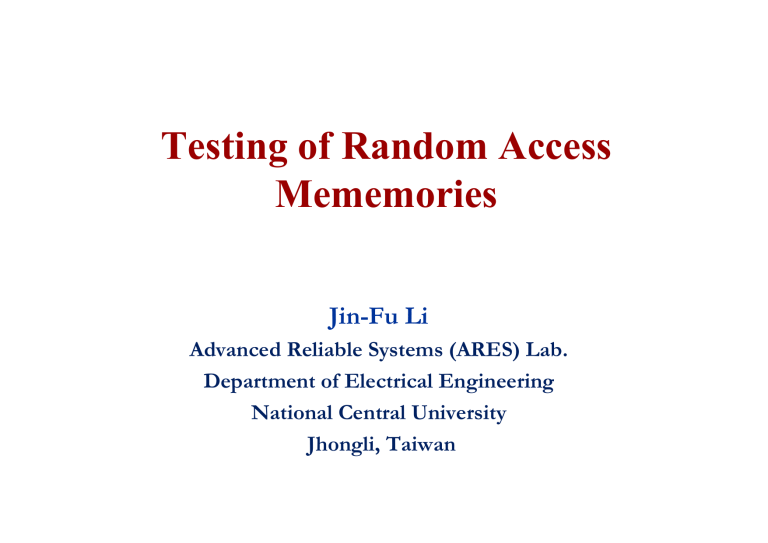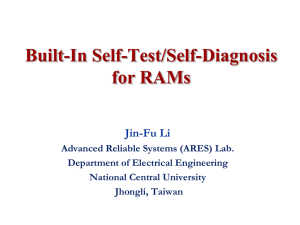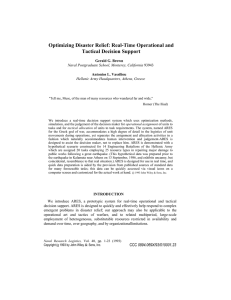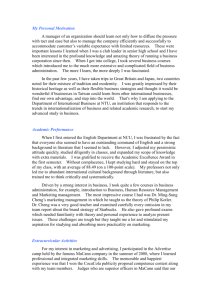
Testing of Random Access
Mememories
Jin-Fu Li
Advanced Reliable Systems (ARES) Lab.
Department of Electrical Engineering
National Central University
Jhongli, Taiwan
Outline
Introduction
Fault Models and Test Algorithms
Fault models
Test Algorithms
Memory BIST/BISD Design
BIST Design
BISD Design
Jin-Fu Li
ARES Lab. EE, NCU
2
Introduction
Modern system-on-chip (SOC) designs typically
consist of hundreds of memories
Memories usually dominate the chip area
Furthermore, memories are designed with the
aggressive design rules such that they are prone
to defects
Thus the memory yield heavily impacts the SOC
yield
Increasing memory yield can significantly increase
the SOC yield
Yield-enhancement techniques for memories
Diagnosis & repair
Jin-Fu Li
ARES Lab. EE, NCU
3
SOC Yield
Yield of an SOC
YS YM YL
Improve the yields of memories can drastically increase
the yields of SOCs
For example, UltraSparc chip yield
Source: R. Rajsuman, IEEE
D&T, 2001
Jin-Fu Li
ARES Lab. EE, NCU
4
Yield Learning Curve
Yield
Diagnosis/repair
Repair
Mature
phase
Early
phase
Intermediate
phase
Jin-Fu Li
ARES Lab. EE, NCU
Time
5
Testing and Repair of RAMs in SOCs
16-core SPARC (Oracle)
DFT features:
1. Scan test + test
compression
2. Programmable memory
built-in self-test (MBIST)
+ repair
3. SerDes internal and
external look-back tests
Jin-Fu Li
ARES Lab. EE, NCU
Niagara2 (Sun)
DFT features:
1. 32 Scans + ATPG
2. BIST for arrays
3. ….
POWER6 (IBM)
DFT features:
1. Logic BIST
2. BIST for arrays
3. BISR for arrays
4. …
6
Fault Models and Test Algorithms
RAM Architecture
2m+k bits
row decoder
row decoder
2n-k words
row decoder
row decoder
column decoder
k
n-bit address
Jin-Fu Li
ARES Lab. EE, NCU
m-bit data I/Os
column mux,
sense amp,
write buffers
8
Bitline Structure
Bit line conditioning
Clocks
word
line
RAM Cell
n-1:k
bit
- bit
Write
k-1:0
Address
Jin-Fu Li
ARES Lab. EE, NCU
Sense Amp, Column
Mux, Write Buffers
Clocks
write data
read data
9
Functional RAM Model
address
address latch
column decoder
row decoder
memory
cell array
write driver
read/write &
enable
sense amplifier
data register
data
in
Jin-Fu Li
ARES Lab. EE, NCU
data
out
10
Reduced Functional RAM Model
Data
Read/write
logic
Memory cell
array
Address
decoder
Address
The address latch, the row, and the columndecoder are combined to the address decoder
They all concern addressing the right cell or word
The write driver, the sense amplifier, and the
data register are combined to the read/write
logic
They all concern the transport of data from and to the
memory cell array
Jin-Fu Li
ARES Lab. EE, NCU
11
Stuck-At Fault & Transition Fault
Stuck-at fault (SAF)
Definition: The logic value of a stuck-at (SA) cell or
line is always 0 or 1. It is always in state 0 or in state 1
and cannot be changed to the opposite state
Detection requirement: From each cell or line, a 0 or 1
must be read
Transition fault (TF)
Definition: A cell that fails to undergo a 0 to 1
transition when it is written is said to contain an up
transition fault. A down transition fault indicates that a
cell fails to undergo a 1 to 0 transition
Detection requirement: Each cell should undergo up
and down transitions and be read after each
transition before undergoing further transitions
Jin-Fu Li
ARES Lab. EE, NCU
12
State Diagram for SAF & TF
w1
w0
S0
w0
S1
w1
State diagram of a good cell
w1
w0
S0
SA0 fault
Jin-Fu Li
ARES Lab. EE, NCU
w1 w0
S1
SA1 fault
w1
w0
S0
w0
TFu
S1
w1
13
Address Decoder Fault
Address Decoder Fault (AF)
An address decoder fault (AF) is a functional fault in
the address decoder that results in one of four kinds
of abnormal behavior:
Given a certain address, no cell will be accessed
A certain cell is never accessed by any address
Given a certain address, multiple cells are accessed
A certain cell can be accessed by multiple
addresses
Jin-Fu Li
ARES Lab. EE, NCU
14
BF & SOF
Bridging Fault (BF)
A bridging fault (BF) occurs when there is a short
between two cells
AND-type BF
OR-type BF
Stuck-Open Fault (SOF)
A stuck-open fault (SOF) occurs when the cell cannot
be accessed due to, e.g., a broken word line
A read to this cell will produce the previously read
value
Jin-Fu Li
ARES Lab. EE, NCU
15
Coupling Fault
Coupling Fault (CF)
A coupling fault (CF) between two cells occurs when
the logic value of a cell is influenced by the content of,
or operation on, another cell
State Coupling Fault (CFst)
Coupled (victim) cell is forced to 0 or 1 if coupling
(aggressor) cell is in given state
Inversion Coupling Fault (CFin)
Transition in coupling cell complements (inverts)
coupled cell
Idempotent Coupling Fault (CFid)
Coupled cell is forced to 0 or 1 if coupling cell
transits from 0 to 1 or 1 to 0
Jin-Fu Li
ARES Lab. EE, NCU
16
State Diagram for CFs
w0/i,
w0/j
w0/i
w1/i,
w0/j
w1/j
S00
w0/j
w0/i
w1/i
S10
S01
w1/j
w0/j
S11
w0/i,
w1/j
w1/i
w1/i,
w1/j
State diagram of two good cells
w0/i,
w0/j
w0/i
w1/i,
w0/j
S00
w0/j
w1/j
w1/i
S01
w0/i
w1/j
S10
w0/j
S11
w0/i,
w1/j
w1/i
w1/i,
w1/j
State diagram of an CFin<u;i>
Jin-Fu Li
ARES Lab. EE, NCU
w0/i,
w0/j
w0/i
w1/i,
w0/j
S00
w0/j
S01
w1/j
w0/i
w1/i
S10
w1/j
w0/j
S11
w0/i,
w1/j
w1/i
w1/i,
w1/j
State diagram of an CFid<u;1>
17
Summary of CFs
Note that all definitions talk about single-way
faults, that is, the presence of a CF from cell i to
cell j does not imply the presence of a CF from
cell j to cell i.
Suppose that a transition or state in cell j can
induce a coupling fault in cell i. cell i is then said
to be coupled cell (or victim); cell j is called the
coupling cell (or aggressor).
A test that has to detect and locate all coupling
faults should satisfy
For all coupled cells, each cell should be read after a
series of possible coupling faults may have occurred
Jin-Fu Li
ARES Lab. EE, NCU
18
CFs in Word-Oriented RAMs
CFs in bit-oriented RAMs
CFs in word-oriented RAMs
Inter-word CFs & intra-word CFs
Intraword CF
Jin-Fu Li
ARES Lab. EE, NCU
Inter-word
CF
19
Neighborhood Pattern Sensitive Fault
Pattern-Sensitive Fault (PSF)
The PSF is a general (multi-cell) coupling fault, which
causes the content of a memory cell, or the ability to
change the content, to be influenced by certain
patterns of other cells in the memory
In general, the number of aggressor and victim
cells may be 4, 5, 9, etc.
The target PSF is the Neighborhood PSF (NPSF)
The aggressor cells are the neighborhood of the
victim cell
5-cell neighborhood
9-cell neighborhood
Jin-Fu Li
ARES Lab. EE, NCU
20
5-Cell & 9-Cell NPSFs
Neighborhood Pattern Sensitive Fault (NPSF)
Type-1 neighborhood
Base cell
Deleted
neighborhood
Type-2 neighborhood
Jin-Fu Li
ARES Lab. EE, NCU
21
Types of NPSFs
Three types of NPSFs
Active NPSF (ANPSF)
Passive NPSF (PNPSF)
Static NPSF (SNPSF)
ANPSF
The base cell changes due to a change in the
pattern of the deleted neighborhood
An ANPSF test has this necessary condition
Each base cell must be read in state 0 and state 1,
for all possible deleted neighborhood pattern
changes
Jin-Fu Li
ARES Lab. EE, NCU
22
Types of NPSFs
PNPSF
A specific neighborhood pattern prevents the base
cell from changing
The necessary condition to detect and locate a
PNPSF
Each base cell must be written and read in state
0 and in state 1, for all deleted neighborhood
pattern permutations
SNPSF
The base cell is forced into a particular state when
the deleted neighborhood contains a particular
pattern
The necessary condition of test is
Each base cell must be read in state 0 and in
state 1, for all deleted neighborhood pattern
permutations
Jin-Fu Li
ARES Lab. EE, NCU
23
Disturb Fault
Disturb Fault (DF)
Victim cell forced to 0 or 1 if we (successively) read
or write aggressor cell (may be the same cell)
Hammer test
Read Disturb Fault (RDF)
There is a read disturb fault (RDF) if the cell
value will flip when being read (successively)
Jin-Fu Li
ARES Lab. EE, NCU
24
Data Retention Fault
Data Retention Fault (DRF)
DRAM
Refresh Fault
Refresh-Line Stuck-At Fault
Leakage Fault
Sleeping Sickness---loose data in less than specified hold
time (typically tens of ms)
SRAM
Leakage Fault
Static Data Losses---defective pull-up
Checkerboard pattern triggers max leakage
Jin-Fu Li
ARES Lab. EE, NCU
25
RAM Test Algorithms
A test algorithm (or simply test) is a finite
sequence of test elements
A test element contains a number of memory
operations (access commands)
Data pattern (background) specified for the Read
and Write operation
Address (sequence) specified for the Read and
Write operations
A march test algorithm is a finite sequence of
march elements
A march element is specified by an address order and
a finite number of Read/Write operations
Jin-Fu Li
ARES Lab. EE, NCU
26
March Test Notation
: address sequence is in the ascending order
: address changes in the descending order
: address sequence is either or
r: the Read operation
Reading an expected 0 from a cell (r0); reading an
expected 1 from a cell (r1)
w: the Write operation
Writing a 0 into a cell (w0); writing a 1 into a cell
(w1)
Example (MATS+): {(w0); (r0,w1); (r1,w0)}
Jin-Fu Li
ARES Lab. EE, NCU
27
Classical Test Algorithms: Checkerboard
Checkerboard Algorithm
Zero-one algorithm with checkerboard pattern
Complexity is 4N
Must create true physical checkerboard, not logical
checkerboard
For SAF, DRF, shorts between cells, and half of the
TFs
Not good for AFs, and some CFs cannot be
detected
1 0 1
0 1 0
1 0 1
Jin-Fu Li
ARES Lab. EE, NCU
28
Classical Test Algorithms: GALPAT
Galloping Pattern (GALPAT)
Complexity is 4N2─only for characterization
A strong test for most faults: all AFs, TFs, CFs, and
SAFs are detected and located
Pseudo code of GALPAT
1. Write background 0;
2. For BC = 0 to N-1
{ Complement BC;
For OC = 0 to N-1, OC != BC;
{ Read BC; Read OC; }
Complement BC; }
3. Write background 1;
4. Repeat Step 2;
Jin-Fu Li
ARES Lab. EE, NCU
29
March Test
An example of march test { ( w1); ( r1, w 0 )}
Addressing Addressing Addressing Addressing
cell 1
cell 2
cell 3
cell 0
(w1)
1
X
1
1
1
1
1
1
X
X
X
X
1
X
1
1
Initial state
X
X
X
X
Addressing Addressing Addressing Addressing
cell 3
cell 2
cell 1
cell 0
(r1,w0)
Jin-Fu Li
ARES Lab. EE, NCU
1
1
1
1
1
1
1
0
1
1
1
0
0
0
0
0
1
1
1
1
1
0
0
0
1
0
0
0
0
0
0
0
30
Detection of SAFs and TFs
MATS+: { (w0); (r0, w1); (r1, w0)}
MATS+ detection of SA0 fault
0 0 0
0 0 0
0 0 0
1 1 1
1 1 1
1 1 1
0 0 0
0 0 0
0 0 0
Good memory Good memory Good memory
after M1
after M2
after M0
0 0 0
0 0 0
0 0 0
1 1 1
0 1 1
1 1 1
0 0 0
0 0 0
0 0 0
Bad memory
after M0
Bad memory
after M1
Bad memory
after M2
MATS+ detection of TFu & TFd can be proved
in the same way
Jin-Fu Li
ARES Lab. EE, NCU
31
Tests for Detecting SAFs & TFs
Conditions for detecting SAFs & TFs
SAFs & TFs can be detected by a march test which
contains the following two march elements (or
single march element containing both elements)
(..., w 0 , r 0 ,...) to detect SA1 faults and TFd
(..., w 1, r 1,...) to detect SA0 faults and TFu
Jin-Fu Li
ARES Lab. EE, NCU
32
Detection of CFs
March C - : { (w0); (r0, w1); (r1, w0); (r0, w1); (r1, w0); (r0)}
Detection of CFs
1 0 0
0 0 0
0 0 0
M1 is
executed
1 1 0
0 0 0
0 0 0
1 1 1
0 0 0
0 0 0
1 1 1
1 0 0
0 0 0
Cell 0 is
Cell 1 is
Cell 2 is
Cell 3 is
addressed addressed addressed addressed
0 0 0
0 0 0
0 0 1
M3 is
executed
0 0 0
0 0 0
0 1 1
0 0 0
0 0 0
1 1 1
0 0 0
0 0 1
1 1 1
Cell 8 is
Cell 7 is
Cell 6 is
Cell 5 is
addressed addressed addressed addressed
Jin-Fu Li
ARES Lab. EE, NCU
1 1 1
1 1 1
1 1 1
Cell 8 is
addressed
1 1 1
1 1 1
1 1 1
Cell 0 is
addressed
33
Tests for Detecting CFs
Conditions for detecting CFs
A march test which contains one of the two pairs of
march elements of Case A & Case B can detect simple
CFs (CFin, CFst, CFid)
Case A
1. ( rx, , w x)
2. ( rx , , w x )
( r x, , wx )
( r x , , wx )
Case B
1. ( r x , , wx ) ( rx , , w x )
2. ( r x , , wx ) ( rx , , w x )
A.1 (A.2) will sensitize the CFs, and it will detect the
fault, when the value of the fault effect is x’ (x), by the rx
(rx’) operation of the first (second) march element when
the coupled cell has a higher (lower) address than the
coupling cell
Jin-Fu Li
ARES Lab. EE, NCU
34
Detection of DRFs
Data retention faults (DRFs)
DRF has two subtypes
A stored ‘1’ will become a ‘0’ after a time T
A stored ‘0’ will become a ‘1’ after a time T
Conditions for detecting DRFs
Any march test can be extended to detect DRFs
The detection of each of the two DRF subtypes requires
that a memory cell be written into the corresponding
logic states
If we are interested in detecting simple DRFs only
The delay elements can be placed between any two
pairs of march elements, e.g., (rx
, , wx) ; Del; (r x,, wx)
Jin-Fu Li
ARES Lab. EE, NCU
35
Tests for Detecting AFs
Conditions for detecting AFs
Condition
Element
1
(rx,, wx)
2
(r x,, wx)
Condition 1
Read the value x from cell 0, then write x’ to cell 0, …,
read the value x from cell n-1, then write x’ to cell n-1
Condition 2
Read the value x’ from cell n-1, then write x to cell n1, …, read the value x’ from cell 0, then write x to cell
0
Jin-Fu Li
ARES Lab. EE, NCU
36
Tests for NPSFs
Type 1 tiling neighborhood
The figure shows that a cell-2 as base cell
The deleted neighborhood of all base cells-2 is
formed by a cell-0, a cell-1, a cell-3, and a cell-4
0
2
4
1
3
0
2
4
1
3
Jin-Fu Li
ARES Lab. EE, NCU
1
3
0
2
4
1
3
0
2
4
2
4
1
3
0
2
4
1
3
0
3
0
2
4
1
3
0
2
4
1
4
1
3
0
2
4
1
3
0
2
0
2
4
1
3
0
2
4
1
3
1
3
0
2
4
1
3
0
2
4
2
4
1
3
0
2
4
1
3
0
3
0
2
4
1
3
0
2
4
1
4
1
3
0
2
4
1
3
0
2
37
Tests for NPSFs
Type 2 tiling neighborhood
Similar to type 1 NPSFs tiling method
0
3
6
0
3
6
0
3
6
0
Jin-Fu Li
ARES Lab. EE, NCU
1
4
7
1
4
7
1
4
7
1
2
5
8
2
5
8
2
5
8
2
0
3
6
0
3
6
0
3
6
0
1
4
7
1
4
7
1
4
7
1
2
5
8
2
5
8
2
5
8
2
0
3
6
0
3
6
0
3
6
0
1
4
7
1
4
7
1
4
7
1
2
5
8
2
5
8
2
5
8
2
0
3
6
0
3
6
0
3
6
0
38
Tests for NPSFs
Two-group method for type 1 neighborhood
Based on the duality of cells: a cell is a base cell in one
group while it is a deleted neighborhood cell in the
other group
A
2
B
2
A
2
B
2
2
C
2
D
2
C
2
D
B
2
A
2
B
2
A
2
2
D
2
C
2
D
2
C
A
2
B
2
A
2
B
2
2 B
C 2
2 A
D 2
2 B
C 2
2 A
D 2
2
D
2
C
2
D
2
C
1
C
1
D
1
C
1
D
A
1
B
1
A
1
B
1
1 B
D 1
1 A
C 1
1 B
D 1
1 B
C 1
1
C
1
D
1
C
1
D
A 1
1 D
B 1
1 C
A 1
1 D
A 1
1 C
B
1
A
1
B
1
A
1
This method can not extend to test type 2 NPSFs
because it depends on the duality concept
Jin-Fu Li
ARES Lab. EE, NCU
39
March Tests for Word-Oriented RAMs
Fault models for word-oriented memories
(WOMs)
Only the class of memory cell array faults for bitoriented memories (BOMs) has to be extended in
order to cover WOMs
The fault models for WOMs can be classified
into two classes
Single-cell faults
SAFs, TFs, data retention faults (DRFs), etc.
Faults between memory cells
CFs
Two classes of faults between memory cells for
WOMs needed to be considered
Jin-Fu Li
ARES Lab. EE, NCU
40
Converting BOM Test to WOM Test
Any given BOM march test can be converted to
a WOM march test
With additional tests to cover intra-word faults
A WOM march test is a concatenation of two
march tests
{Inter-word march test, intra-word march test}
The inter-word march test can directly be
obtained from the BOM march test
Replace the bit-operation “r0”, “w0”, “r1”, and “w1”
with the word-operation “rD”, “wD”, “rD’”, and “wD’”,
where D is called data background
Jin-Fu Li
ARES Lab. EE, NCU
41
Converting BOM Test to WOM Test
The intra-word faults can be detected by a single
march element with different operations and data
backgrounds
E.g., intra CFst can be covered by (wd1, rd1,...,wdn , rdn )
with various data backgrounds (DBs)
Note that the DBs can be applied in any order
The above intra-word test can be modified as
follows, without any impact on the fault
coverage
Extra Read operations can be added
The single march element can be divided into any
number of march elements, and for each march
element the addressing order can be chosen freely
Jin-Fu Li
ARES Lab. EE, NCU
42
Cocktail March Tests for WOM
If you have a bit-oriented march test, then you
can obtain a compact WOM test with
Replace the bit-operation “r0”, “w0”, “r1”, and “w1”
with all-0 and all-1 data backgrounds
Concatenate a march element ( wd1 , rd1 ,..., wd n , rd n ) for
d={0101..01,0011..11, …}
For example, the March C- can be extended as
follows to test a memory with 4-bit words
{ ( w 0000 ); ( r 0000 , w11111 ); ( r11111 , w 0000 );
( r 0000 , w1111 ); ( r1111 , w 0000 ); ( r 0000 );
( w 0101 , w1010 , r1010 , w 0101 , r 0101 );
( w 0011 , w1100 , r1100 , w 0011 , r 0011 )}
Jin-Fu Li
ARES Lab. EE, NCU
43
Memory BIST/BISD Designs
General BIST Architecture
Test
Generator
Circuit Under Test
(CUT)
Response
Verification
Test Controller
Jin-Fu Li
ARES Lab. EE, NCU
45
An Example of ROM BIST
Counter
MISR
Controller
Go/No-Go
Jin-Fu Li
ARES Lab. EE, NCU
ROM
Status
46
Typical RAM BIST Architecture
Normal I/Os
Test Pattern
Generator
Go/No-Go
Jin-Fu Li
ARES Lab. EE, NCU
Test Collar
Test Controller
RAM
Comparator
47
FSM-Based BIST
An example of the state diagram of controller
Jin-Fu Li
ARES Lab. EE, NCU
W0
S0
R0
S1
W1
S2
R1
S3
W0
S4
R0
S5
W1
S6
End
S7
NOT last address?
NOT last address?
NOT first address?
NOT first address?
48
Programmable RAM BIST
An example of the programmable RAM BIST
Normal I/Os
BRS
BGO
Controller
BSC
TGO
ENA
DONE
Test Collar
BSI
TPG & Comparator
CMD
RAM
CLK
BNS
Jin-Fu Li
ARES Lab. EE, NCU
49
FSM State Diagram of Controller
Idle
DONE=1
BRS=1
BSC=1
Shift_cmd
BSC=0
Get_cmd
Apply
ENA=1
DONE=0
Jin-Fu Li
ARES Lab. EE, NCU
50
Programmability
The programmability can be achieved by using test
command
The test command format
Data background
U/D OP
U/D: ascending/descending address
sequence
OP: test operations
For example, wa, rawa’, rawa’ra, warawa’ra’, etc.
Data backgrounds
The width of each field affects the programmability of
the BIST design
For example, if 4 bits are used for OP, then only 16 possible test
operations can be generated
Jin-Fu Li
ARES Lab. EE, NCU
51
FSM State Diagram of TPG
Idle
ENA=0
ENA=1
Init
Null=1
Null=0
DONE/GO
Ifetch
Exec
Dfetch
No-Go
Jin-Fu Li
ARES Lab. EE, NCU
Error=1
Compare
Error=0
52
Shared Memory BIST Architecture
TPG
Test Collar
RAM 2
TPG
Test Collar
Jin-Fu Li
ARES Lab. EE, NCU
Test Collar
BIST_CS
CTR
TPG
RAM 1
RAM N-1
53
Multiple RAM Groups
TPG
Test Collar
RAM 1
TPG
Test Collar
RAM 2
TPG
Test Collar
RAM k
TPG
Test Collar
1500 Wrapper
WSI
RAM N-1
CTR
WSO
WSC
WSI
Jin-Fu Li
ARES Lab. EE, NCU
1500 Wrapper
WSO
CTR
54
Multiple RAM Groups
Test Collar
Test Collar
TPG
Test Collar
RAM k
TPG
Test Collar
RAM N-1
Data Register
Decoder
TRST
TAP
Controller
Bypass Register
Instruction Register
TDO
CTR
TMS
Data Register
TPG
RAM 2
TCK
55
Jin-Fu Li
ARES Lab. EE, NCU
CTR
TPG
RAM 1
TDI
RAM BISD
Embedded memory test and diagnosis is an
important issue in SOC development
BIST is a cost-effective solution, even is the best
solution, for embedded memories
Low cost
At-speed testing
Low pin count overhead
A BISD design for embedded memories includes
BIST
Diagnostic data receiver (DDR)
Jin-Fu Li
ARES Lab. EE, NCU
56
RAM BISD Architecture
ADDR
DI
DO
WEB
CS
OE
BEF
BSO
DDR
ADDR_T
ERR
EOP
CONT
DI_T
DO_T
BS
I
BMS
BSC
BRS
BGO
CMD
TGO
CTR
TPG
WEB_T
DONE
CS_T
ENA
OE_T
ADDR_S
DI_S
DO_S
WEB_S
SRAM
CS_S
OE_S
CLK
Test_se
Source: C.-W. Wang, et al., IEEE ATS, 2000.
Jin-Fu Li
ARES Lab. EE, NCU
57
BISD in Diagnosis Mode
In diagnosis mode it can run user-specified
march algorithm for test/diagnosis
Session
Syndrome
EOP format: Addr
A sample of timing diagram is as follows
CLK
ERR
EOP
1001....10
BEF
BSO
CONT
Jin-Fu Li
ARES Lab. EE, NCU
58





